The Best Clothing Color Palettes for Men

Key Takeaways
Color affects how others perceive you and how you feel — it's the perception of trust, power, and sophistication. Choose blue for trust, red for vitality and impact and black for sophistication, but tailor accordingly to context and culture.
💫 Build Your Perfect Color Palette
Ready to create a personalized color palette that works perfectly with your style? Our comprehensive guide will help you build a wardrobe palette that enhances your natural features and fits your lifestyle.
Build My Palette →Think outside the blue box and jazz up your look with greens, purples and eye-popping reds. Retain blue as your foundation and accent with olive, burgundy and teal for a dynamic appearance.
Mind your cultural and generational color codes to remain appropriate and up-to-date. Study local customs for worldwide events and follow younger movements that embrace more daring palettes.
Discover your optimal colors through undertone, contrast level and style testing. Color for guys – Use a color wheel, construct a core palette and play with shades near your face to amp confidence.
Construct ensembles with obvious **color palette**s for effortless polish. Go monochrome for ease, analogous for harmony and complementary color for striking equilibrium, grounded in adaptable neutrals.
Color for men Select navy and charcoal for work, fun pops for casual dates and timeless darks for black tie and rule-bending brilliance.
Color for male explores how men pick and rock colors in clothes, grooming and spaces to suit style, mood and culture.
Men gravitate toward navy, gray, olive and black for every-day, with earth tones and gentle pastels providing variety.
**Skin tone**, lighting and context dictate what works best. Warm tones for golden skin, cool for rosy.
Bright pops of color, like a teal watch strap, provide equilibrium.
The following sections organize sample selections by requirement and environment.
📚 Recent Articles
The psychology of color for men
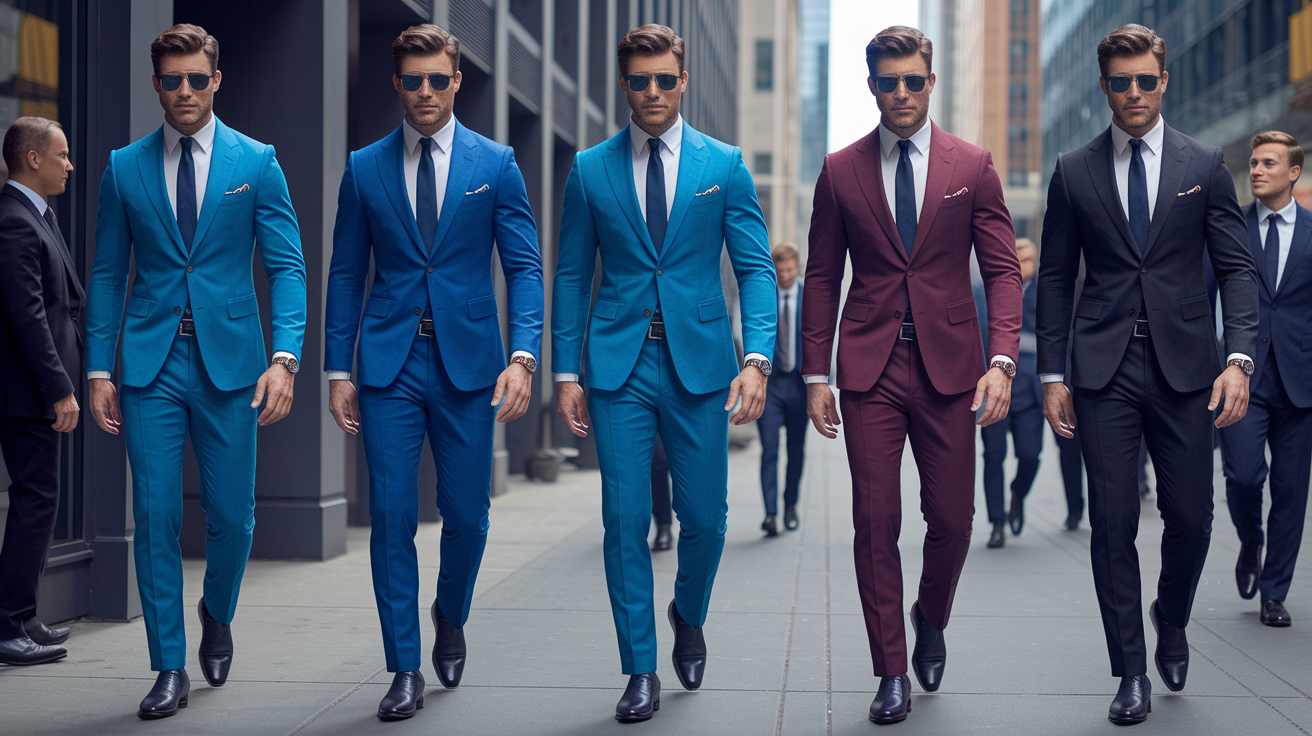
Color influences how others interpret mood, status and intention. In clothing it directs attraction, confidence and first impressions in seconds. Blue tends to communicate trust and calmness, whereas black denotes control and polish. Red reads as bold and persuasive – a 2014 study linked red to stronger influence.
Men, on the other hand, have neuter preferences – gray, navy and black, because they look dependable and go with everything. Men's favorite color is blue, research shows, with red in third place. Tastes remain pretty consistent through the decades, however context and memory are significant — a pastel that feels calming to one man can feel "washed out" to another.
Your aim is not one ideal hue, but a color palette that complements your stylistic persona and what you want to communicate.
Beyond blue
Blue is a safe base and pairs with most tones, which is why so many wardrobes lean heavy on it. A simple rule of thumb: about 26% blue works well, with navy at roughly 14% and indigo near 12%. That foundation provides you some space to experiment.
Go green for equilibrium—olive chinos paired with a navy knit, or a forest green overshirt with a white T. Purple can look rich, not flashy: think aubergine tie with a charcoal suit, or a muted plum sweater on cool days. Electric reds inject pep in measured doses — a scarlet watch cap, a brick belt, scarlet sneakers rev up a dull ensemble.
Versatile boosts for blue: olive, camel, charcoal, white, burgundy, forest green, cream, rust, and soft purple. Let blue be your constant. Layer accents at the edges — scarves, watches, pocket squares, sneakers — so the look comes across dynamic, not loud.
Cultural codes
Color cues change by location, affecting how we perceive different colors. For instance, white can read as formal in one area and ceremonial in another. Similarly, red can represent happiness, fortune, or power in various cultures. In some markets, black is seen as business attire, while in others, dark gray or navy is preferred for a more subtle approach, particularly for those with a medium contrast complexion.
If you think about a typical business palette – navy, charcoal, and white shirts, and then festive colors can be gold, bright red, and bright green in some parts of the world. That divide dictates what hues "work" at the office versus party.
Before an international event, check norms by reviewing host-country guidelines and company dress codes. If you're uncertain, opting for a neutral color suit and adding local colors as accent colors is a safe choice.
Respect comes first with bold shades. Shoot for consonance with tradition, not manifesto for the hell of it.
Generational shifts
Younger men tend to gravitate towards brighter palettes, high-contrast fits, and selected pastels. Some stroke their pastel pinks, mint greens, or warm neutrals and feel calm and reflective, others still perceive them as faint.
Social media accelerates this transition, making international streetwear, sports uniforms and runway releases into color signals on a weekly basis. Older cohorts still love their classics—navy, gray, black, white—because they're timeless and pragmatic. Gray in particular remains flexible across environments.
Fashions move quickly these days, but men's fundamental preferences—blue #1, then deep shades, then bright reds—have been consistent for roughly 50 years. Follow color waves via lookbooks and athlete tunnels, but anchor your base. Throw in trend colors in layers you can switch out when the season shifts.
How to find your best colors

Begin with what your skin tone, hair color, and eye color are already saying. Then, employing a color wheel, test actual clothes close to your face and hone in on a unique color palette you can wear everywhere.
1. Your skin undertone
Determine your undertone first. Use the Vein Test on the inner wrist: green veins lean warm, blue or purple veins mean cool, and mixed or hard-to-read veins may be neutral.
Note metal: gold tends to flatter warm, silver flatters cool. Cool undertones thrive on cool blues, charcoal, crisp white, true red and emerald. Warm undertones look sharp in earth tones like olive, terracotta, camel and golden brown.
Neutral undertones can borrow from both, then tune by depth—lighter skin typically favors softer tints, while darker skin can carry richer colors. Undertones influence how colors read on light, olive or dark skin.
Light cool skin can wash out in pale yellow but sparkle in navy. Olive (usually warm or neutral) makes olive green and burnt orange seem organic. Your dark cool skin makes cobalt, royal purple and burgundy look vivid and clean.
Try out shirts or tees or scarves close to bare face in daylight. If skin looks clear and eyes brighten, it's right. If shadows, redness or dullness appear, switch the shade or go lighter/darker.
2. Your contrast level
Contrast is the difference between your hair, skin and brows. **High contrast**: dark hair with light skin, or very dark skin with bright whites in the eyes. **Low contrast**: hair and skin close in depth. Medium sits in the middle.
High contrast favors bold combinations—navy jacket, white shirt, burgundy tie; black jeans, white tee, cobalt jacket. Low contrast does better with gentle shifts—stone with light grey, sage with sand, soft denim with white.
Medium can mix both: charcoal with mid-blue and a subtle pop. Try to use contrast to shape the face. A monochromatic look can gain depth with one crisp pop—white pocket square with navy suit—to emulate nature's contrast and bring attention.
3. Your personal style
Color that fits your life. If you travel, rely on neutrals—navy, grey, white—that match with everything and get through dress codes. Build a core set: two dark neutrals, one light neutral, one mid neutral.
Then sprinkle in any accent colors you adore — forest, rust, or deep teal if warm undertones; cobalt, ice grey, or cool burgundy if cool. Select a couple of signature colors you keep coming back to.
They make shopping simple and your style stick.
4. Your environment
Adjust to climate, season and conventions. In warm places, light colors and natural fibers wear cooler. In chilly environments, richer colors appear correct and conceal wear.
Follow workplace cues: navy and grey read professional. Top it off with an understated tie or pocket square for personality. For functions, check the dress code, then color inside that outline.
Use seasonal shifts to recharge. Pastel shades such as soft pink, baby blue or mint green come alive in summer, particularly against the backdrop of **lighter complexions**.
Autumn and winter invite in burgundy, crimson and deep brown while lighter greens are suited to spring and summer, whereas the deeper greens perform better during the colder months. Confidence and comfort trumps rules. If a color raises your spirits, it's got a spot.
The foundational color palette
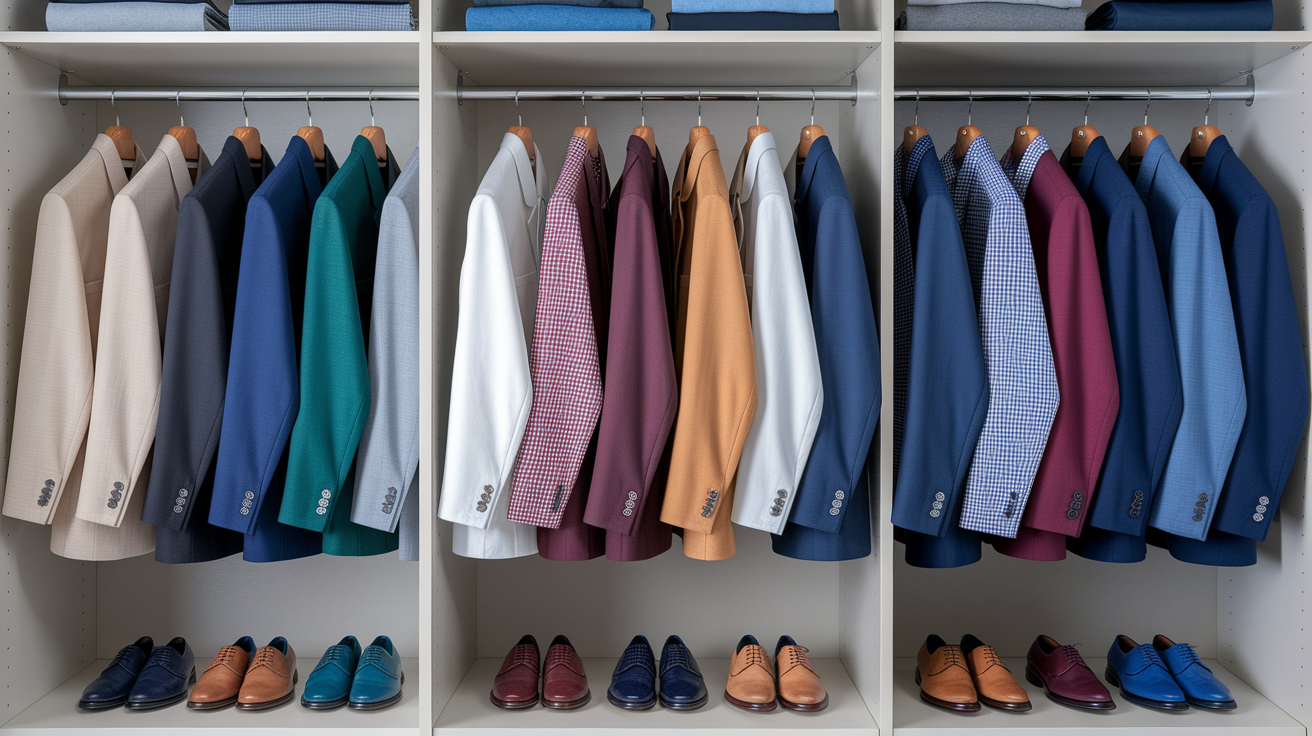
A killer palette makes dressing every day quicker and crisper. Strive for a close blend of neutrals, a few pops, and a shade or two of WOW! Construct the bulk of your outfits from ground colors, then add interest in small doses.
1. Neutrals: navy blue, grey, white, black, charcoal, brown, tan, and stone. These make up the backbone, travel between settings and go with just about anything. 2. Accents: burgundy, olive, mustard, teal, rust, and soft pastels like mint or sky blue for warm months. Apply to inject mood and depth. 3. Statements: vibrant red, electric blue, deep purple, and saturated jewel tones such as plum or forest green. Apply to guide the eye on statement pieces.
Maintain the wardrobe at roughly 70-80% neutrals, 15-20% accents and 5-10% statements. This equilibrium keeps the look cohesive, yet allows space for character.
The neutrals
* Navy blue: a timeless base for suits, chinos, knitwear; fits formal to casual. * Grey: a true neutral; from light to charcoal; blends with nearly all hues. * White: crisp tees, shirts, and sneakers; brightens darker pieces. * Brown: warm and grounded; great in leather, knitwear, and tailoring. * Black: sharp and clean; best in outerwear, denim, and shoes. * Tan/stone: light, easy layers that soften strong colors.
Neutral pieces serve as the skeleton. A navy jacket, grey trousers and a white shirt connect with infinite possibilities, from a brown belt and loafers to a black boot and tee exchange. Items in these tones cycle without becoming tired.
Invest in quality: a mid‑weight navy blazer, charcoal wool trousers, brown leather shoes, and a white oxford. Quality fabric and fit stretch each piece across seasons.
Mix neutrals with accents or one statement color to crisp the look noiselessly.
The accents
Pops of color make a statement without screaming. Consider burgundy, olive, mustard, teal and earth tones like terracotta and caramel for a little warmth.
Accent it with belts, scarves, caps, socks and ties or knit polos or suede shoes. Burgundy knit with grey trousers and whites sneaks says smart and easy.
Keep accents to just one or two per outfit for cohesion. Rotate hues seasonally — mint and sky blue during spring and summer, richer hues during autumn and winter. Light and skin tone shift throughout the year, so test in daylight.
The statements
Statement colors are bold: vibrant red, electric blue, deep purple, or rich jewel tones like plum and forest green. Embrace them as points of focus — a jacket, overshirt or one pair of sneakers — so the eye settles once.
Counterbalance with neutrals to stabilize the appearance. A forest green coat atop black denim and a grey knit feels collected and powerful.
Select shades that complement your complexion and suit your style. Try on by a window – minute shifts in light can tip what works.
Building outfits with color
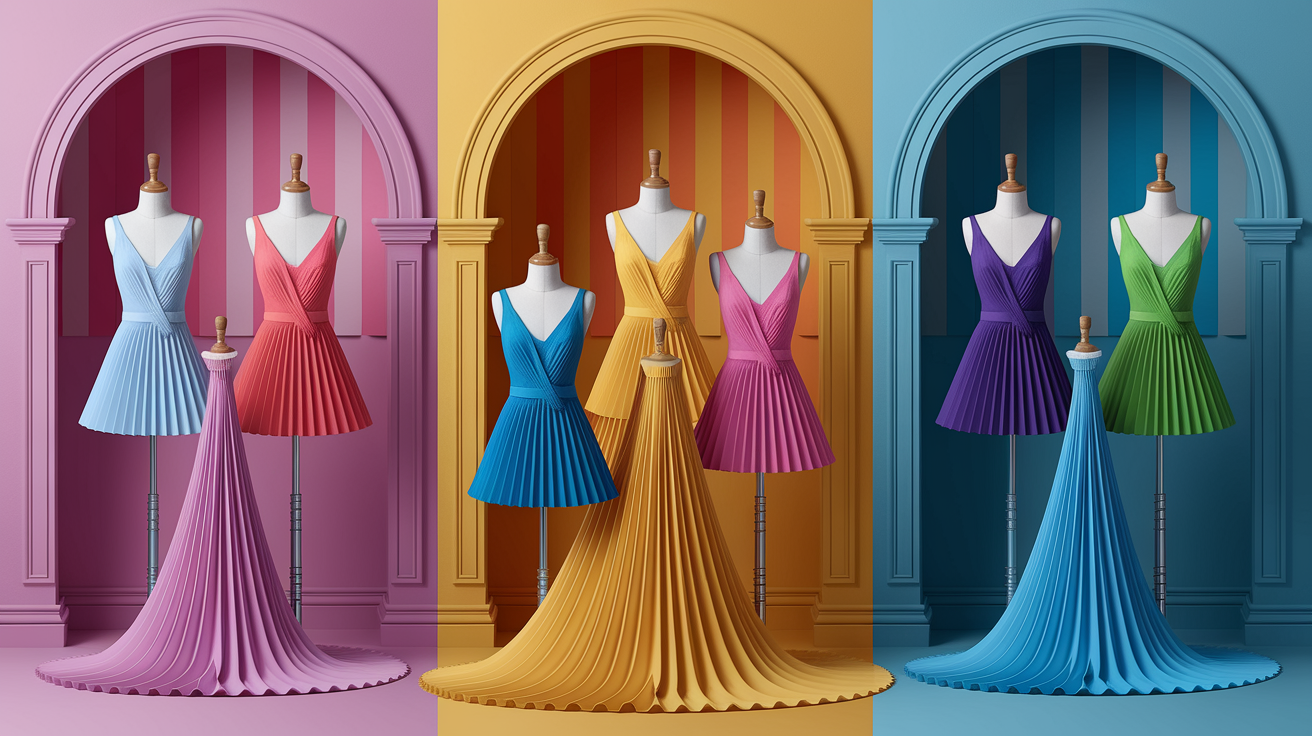
Color establishes a mood before a syllable is spoken. Approximately 60% of a first impression rests in color, so picking a palette counts. Work with a clear plan: a dominant hue at 60%, a secondary at 30%, and a 10% accent.
Keep neutrals — black, white, grey, brown — as a base; they don't count toward the three-color limit. Keep the 60% piece calm and season-right like lighter greys in summer and darker greys in winter. Skip bright colors in the 60% position.
Light colors dazzle in the 30% mode, creating contrast without creating noise. Different tones of the same color count as one, but each color in a pattern counts. Contrast, so that you never appear as one big tonal block.
Monochromatic
Monochrome = 1 colour, lots of shades, tints and tones. Something along the lines of a navy jacket, mid‑blue shirt and washed blue denim. Your eyes see it as sleek, but the shade shifts bring shape and depth.
Texture rescues a monochromatic ensemble from floundering. Mix matte with sheen: wool blazer, cotton tee, suede shoes. Denim with knits. Linen meets leather. The surfaces disrupt the color field.
Go with all-blue or all-grey to get started. Great for building outfits with color, these palettes are easy to mix match, work year-round and play nicely in formal or casual frames.
Experiment with charcoal suit, silver-grey shirt, slate tie. Monochrome reads clean, simple, and sharp on men. It's subtle, but it looks sophisticated.
Analogous
Analogous colors sit next to each other on the wheel: blue, teal, green. They mix effortlessly and soothe the eye. It's an easy foolproof way to inject some color without battles between shades.
Use them when you desire harmony. Olive chinos with moss knit and a teal scarf. Rust overshirt atop sand tee and tan boots. The family link keeps it flowing.
Vary intensity for interest. Pair muted forest with bright sage, or deep navy with soft sky. Adjust one piece's color intensity with the others muted.
Balance with neutrals so it doesn't melt into a blob. Anchor with white sneaks, grey coat or a brown belt. The neutral frame shapes the color story.
Complementary
Complementary colors face each other on the wheel—blue with orange, red with green, purple with yellow. They ignite contrast, so use with caution.
Use accents to pop: A blue suit, burnt orange pocket square. Olive jacket, burgundy beanie. Navy knit with copper watch strap.
You want to have one color be the dominant and the other support. Let's say 60% navy, 30% grey, and 10% orange. The navy and grey keep things in order, the orange commands your attention.
Most appreciated in casual or creative milieus. Weekend fits, smart-casual offices, or events where personality counts. Track patterns: each new color counts toward the three-color rule.
| Dominant (60%) | Secondary (30%) | Accent (10%) | Outfit Idea |
|---|---|---|---|
| Navy | Grey | Burnt orange | Navy suit, grey shirt, orange pocket square |
| Charcoal | White | Burgundy | Charcoal coat, white tee, burgundy scarf |
| Olive | Khaki | Gold | Olive overshirt, khaki chinos, gold watch |
| Beige | Light blue | Forest green | Beige knit, light-blue shirt, green cap |
Colors for different occasions
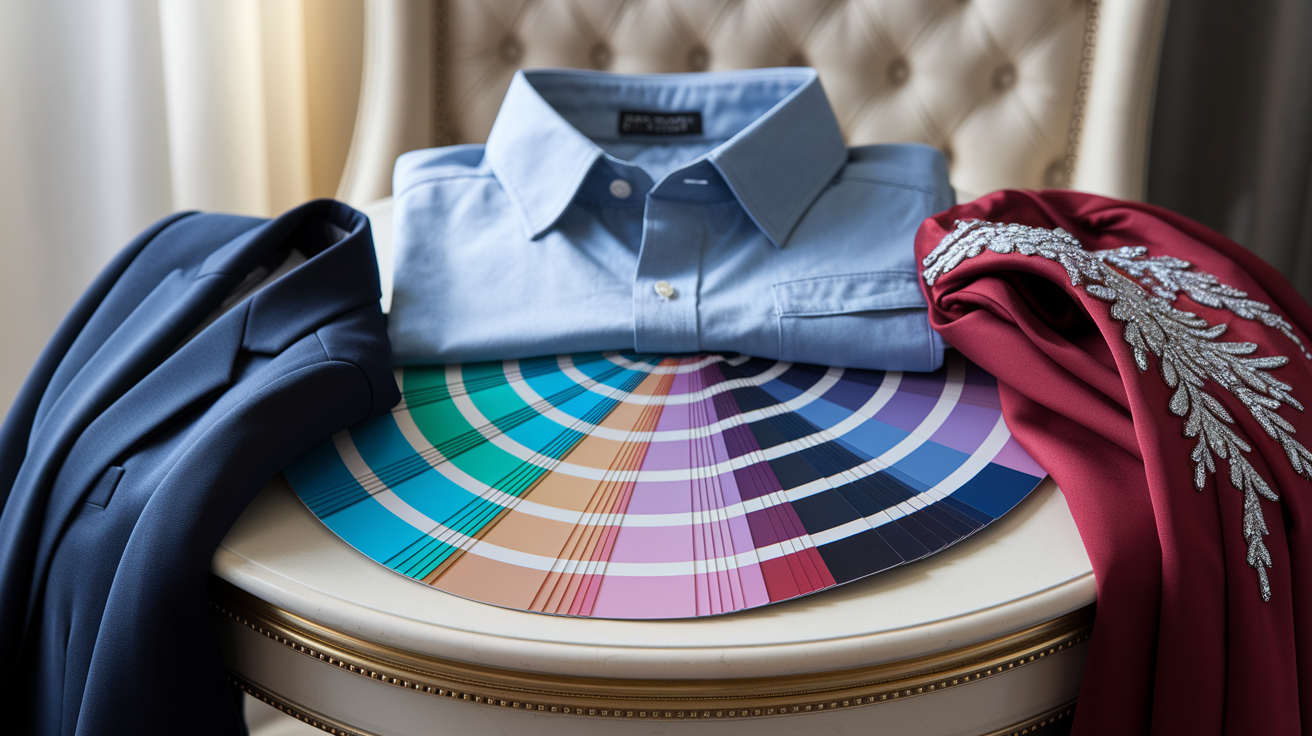
Try for a compact color palette you can stretch to work, weekends and black tie events. The appropriate color complements the environment and enhances serene, lucid courage.
- Professional: navy, charcoal gray, white, light blue, black accents
- Casual gatherings: olive, sand, denim blue, soft pink, coral, pastel green
- Formal events: black, midnight blue, deep gray, burgundy accents, silver
- Summer: vibrant blues, greens, coral, yellow; light gray
- Autumn/Winter: forest green, burgundy, plum, dark gray, navy
- Avoid: loud neons in strict offices. red-and-green combinations beyond the holidays
Professional settings
Start with a foundation of navy, charcoal gray, and white, as these neutral colors look sharp on a variety of skin tones. They convey a composed image, perfect for meetings or interviews. A light blue shirt adds a touch of calmness without being overwhelming, while mid-to-dark gray serves as a versatile color throughout the year—lighter shades for spring and summer, and darker tones for autumn and winter.
Work in small accents to demonstrate breadth. Consider, for example, a burgundy tie with a charcoal suit, a slate-blue pocket square with navy, or a pale pink oxford under a gray blazer. Keep saturation low and patterns tight. In strict offices, avoid neon, flashy pastels or high-contrast novelty prints.
Neutrals communicate dependability because they dampen image volatility. They go with most shoes and belts, which keeps things simple on hectic mornings.
Casual gatherings
Color breathes here. Go for brighter blues, greens, or bolder choices — think coral or yellow in summer — to give a fresh pick-me-up. Pastels—mint, powder blue, soft pink—seem fresh in heat, and compliment lighter complexions.
Mix color through one item: a sage tee, rust chinos, or sea-blue sneakers. Then anchor it with denim, white, gray, or navy. If your shirt is bright, keep your shorts muted. If the sneaks pop, let the top be mellow.
Coordinate with the spirit and season. Light greens and soft blues go in the spring and early summer. Deeper greens sparkle in the fall and winter, with burgundy or plum for dimension. Your year-round anchor, gray, is light in warm months and dark when it's chilly.
Ditch clash-prone pairings like strong red with strong green, unless the party theme insists. Soft blues, greens and pinks are good bridge colors when transitioning out of winter.
Formal events
Depend on black, midnight blue or deep gray for suits and tuxedos; they photograph well and are both safe bets for weddings and formal dinners. Darker hues assist at job interviews when the attire tends to be on the formal side.
Keep personality in the details: a rich burgundy tie, a midnight pocket square with a faint sheen, or cuff links with a subtle color note. First follow the dress code, then add a quiet accent.
Fabric sheen may make a difference at night. A fine wool with a bit of a lustre or a satin lapel deepens color and provides a sharp edge without screaming.
Bending the color rules
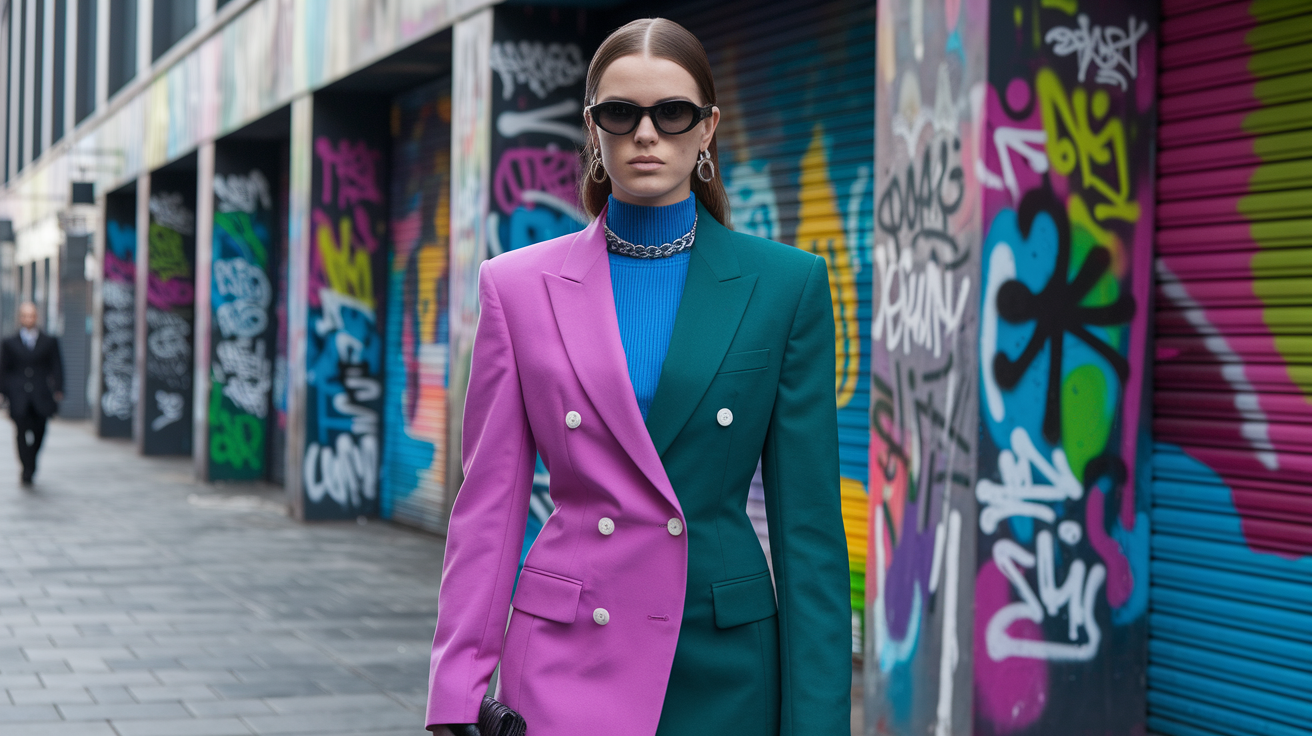
Color rules assist initially, then you tweak them. Understand the three-color rule and basic harmony before you bend the rules. Bend the color rules. Use neutrals — black, white, grey, brown — as your base; they don't count toward the three.
I stick to most looks to three colors, because more can distract from your face. For color-bending, treat hues in the same family as one color, like navy with light blue. Patterns add up: each shade in a stripe or check counts. About: Metallics play nice with any palette. Leave neon to sport or costumes; it screams too loud for daily wear.
Intentional clashes
Deliberate clashes combine hues that "aren't a match" in the traditional sense—red and pink, rust and magenta, saffron and teal. They read brash, contemporary and a touch art-school. The objective is stress without racket.
Go small to test the blend. A clashing beanie, socks or scarf can change an entire look when the foundation is neutral. A pink tee under a navy blazer with burgundy sneaks is the test run with the least danger. If it works in little chunks, take it up a notch with a shirt or knit.
Dress conflicts with definitive opinion. Stand tall, keep open posture and skip added patterns that muddle the eye. If the colors do tell the story, let them tell it. Bend the color rules. Keep track of victories on your phone—snap images and record the hues, make and light. Your own archive will accelerate subsequent decisions.
Unconventional pairings
Think beyond the color wheel. Experiment with color combinations — soot green with lilac, chocolate brown with sky blue, charcoal with mustard. Bend the color rules, pair muted with vivid for balance—dusty rose next to cobalt, sage next to tomato red. The beige mutes the punch while the chartreuse lifts the look.
Use these pairings to show what you value: calm with edge, sharp with ease. Bend the color rules. A basic white shirt, grey trousers and sneakers allowed a violet jacket and olive cap to shine. Stick to three colors, not including neutrals, and be honest and count pattern colors.
If you throw in a blue-and-yellow stripe tie, that's two colors right there, so be careful planning the rest.
Personal expression
Color sets tone and narrates your tale. Build a color profile: note which hues flatter your skin, which shades mirror your values, which tones fit your life.
Introduce a new color every month. Bend the color rules, experiment with it in socks, then a tee, then outerwear. Post your best mixes to friends or online – comments develop courage, and your inspiration assists others.
Once the basics feel second-nature, bend them. Mix metals, blend tones in the same family and bend rules with purpose, not impulse.
Conclusion
So to round up color has the ability to elevate a look, create a mood and communicate style. Little edits do serious labor. A navy tee tempers stone sharp jeans. A moss green overshirt brings dimension to a gray foundation. A clean white sneaker freshens up a dark fit. These moves seem smooth, but they look sophisticated.
To make advancement manageable begin with the basics. Whether it's one rich hue or one bold accent. Try in fine light. Snap a pic. SEE how skin, eyes & hair respond. Hold what compliments. Avoid what saps.
To keep agile, implement swaps. Swap black for charcoal. Trade bright red for rust. Stir in texture to make it pop.
Go for one new color this week and see how it feels.
Frequently Asked Questions
What colors look best on most men?
Neutrals such as navy, charcoal, white, and olive complement a majority of skin tones, including low contrast skin tones. They're versatile and simple to match. Infuse your outfit with accent colors like burgundy or forest green for depth, then experiment with richer shades in great light.
How do I find my best colors quickly?
Determine your undertone to find the right color choice. If veins appear blue, opt for cool colors (navy, gray); if green, warm colors (olive, camel) work best. A neutral color means most colors fit. Try it on a tee under daylight and compare.
What is a solid foundational color palette?
Construct around navy, charcoal, gray, white, black, and olive skin tones. Incorporate one or two accent colors, such as burgundy or tan skin, to create a versatile color palette that spans work, casual, and events with a minimum of pieces and maximum combinations.
How do I combine colors without clashing?
One main color, one neutral color, and one accent color create a versatile color palette. Maintain saturation and avoid combining too many bold colors! If in doubt, ground in navy or gray, then pair with a subdued pop of spring colors like rust or sage.
Which colors are best for different occasions?
Work: navy, charcoal, light blue. Casual: olive, denim blue, tan. Formal: black, midnight blue, white shirt. Summer events: beige, light gray, pastel blue. Evening: deep tones like burgundy or forest green.
Can men wear bright colors confidently?
Yes–maintain the base as neutral colors. Use bright colors as accent colors: a T-shirt, sweater, or sneakers. One bold piece per outfit, please. Pair with classic cuts and textures to appear refined, not flashy.
When is it okay to bend color rules?
Bend rules when the cut's crisp and the atmosphere's casual. Experiment with tone-on-tone looks, surprising combos (navy with brown) or seasonal colour palettes. Style is more important than 'rules'—try it, see, adjust. Bend the color rules. Keep track of victories on your phone—snap images and record the hues, make and light. Your own archive will accelerate subsequent decisions.